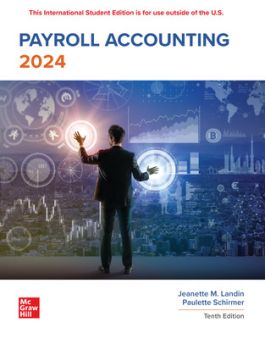Payroll Accounting 2024 ISE
To access your eBook, sign in or register at McGraw Hill Bookshelf and you will be instructed to enter your access code.
After adding your eBook to the McGraw Hill Bookshelf, download the ReadAnywhere app on the App Store or Google Play. Sign into your McGraw Hill Bookshelf or Connect account to access your eBook on the go and download chapters for offline reading.
For McGraw Hill eBook & ReadAnywhere support, click here.
Chapter 2: Payroll System Procedures
Chapter 3: Gross Pay Computation
Chapter 4: Fringe Benefits and Voluntary Deductions
Chapter 5: Employee Net Pay and Pay Methods
Chapter 6: Employer Payroll Taxes and Labor Planning
Chapter 7: The Payroll Register, Employees' Earnings Records, and Accounting System Entries
Appendix A: Comprehensive Payroll Project: Wayland Custom Woodworking
Appendix B: Special Classes of Federal Tax Withholding
Appendix C: Federal Income Tax Tables
Appendix D: State Income Tax Information
Appendix E: State Revenue Department or Labor Information
Appendix F: Payroll Certification Information
The tenth edition of?Payroll Accounting?continues the author’s tradition of providing a modern approach to payroll accounting incorporating coverage of real-world issues that many students will face in their careers, such as cybersecurity, payroll fraud, artificial intelligence, and labor costs. The textbook content paired with Connect materials?contribute to a comprehensive understanding of payroll accounting in the twenty-first century and will make accounting students more valuable to the organizations they work for in their careers. Whether you are teaching face to face, hybrid, or online, Payroll Accounting 2024 is flexible enough to be used in courses as short as 3 weeks and as long as 15 weeks.
This text is different than others because it is written with the perspective that payroll is the story of people. These people include the ones within the business who make decisions about the company’s directions and the people who work for the business and depend on their paychecks to support their livelihoods. To foster the connection between business and people, each chapter’s introductory story contains recent events involving payroll accounting that highlight the connections among payroll, legislation, business decisions, and people affected by all the decisions made. Chapter 1 highlights a shift in workers’ attitudes to work that emanated from the changes to the work environment during COVID-19 shutdowns: the demand for a better work-life balance supported by employers. Chapter 2 discusses the current movement of refugees into the workplace and highlighted the difference between H-1B and refugee work visas. Chapter 3 explores the challenges of new pay transparency laws that have been enacted in many places. Chapter 4 explores the need for flexible benefits that suit both traditional and remote workers and the “out of sight, out of mind” challenges that remote workers face. Chapter 5 focuses on the demand for flexible pay or on-demand pay that is gaining popularity. Chapter 6 discuss the challenge of rising labor costs that employers face, many of which have resulted in layoffs. Finally, Chapter 7 introduction considers the effects of artificial intelligence, the Great Resignation, and COVID-19, all of which have led to a shortage of accountants.
The author team has made content updates including updating the payroll processing options in Chapter 1 to reflect an accurate representation of the current state of the available technology used by businesses of any size. Chapter 2 explores situations where an individual may have multiple employers and how to report new employees per legal requirements. Cybersecurity and payroll is also covered in more depth in Learning Objective 2-5 to attenuate students to this growing concern. The section about cryptocurrency has been updated as a means of transmitting payroll amounts due in Learning Objective 5-6. It is important to understand that cryptocurrency as a means of paying employees, while being considered, is a complicated issue because of its connection to the stock market, as opposed to a central bank, as a basis for its value.
McGraw Hill Connect is an award-winning digital teaching and learning solution that empowers students to achieve better outcomes and enables instructors to improve course management efficiency.
High-Quality Course Material
Our trusted solutions are designed to help students actively engage in course content and develop critical higher-level thinking skills while offering you the flexibility to tailor your course to the ways you teach and the ways your students learn.
Assignments & Automatic Grading
Connect features a question bank that you can select from to create homework, practice tests and quizzes. Dramatically reduce the amount of time you spend reviewing homework and grading quizzes, freeing up your valuable time to spend on teaching.
Analytics & Reporting
Monitor progress and improve focus with Connect’s visual and actionable dashboards. Reports are available to empower both instructors and students with real-time performance analytics.
Seamless Integration
Link your Learning Management with Connect for single sign-on and gradebook synchronization, with all-in-one ease for you and your students.


